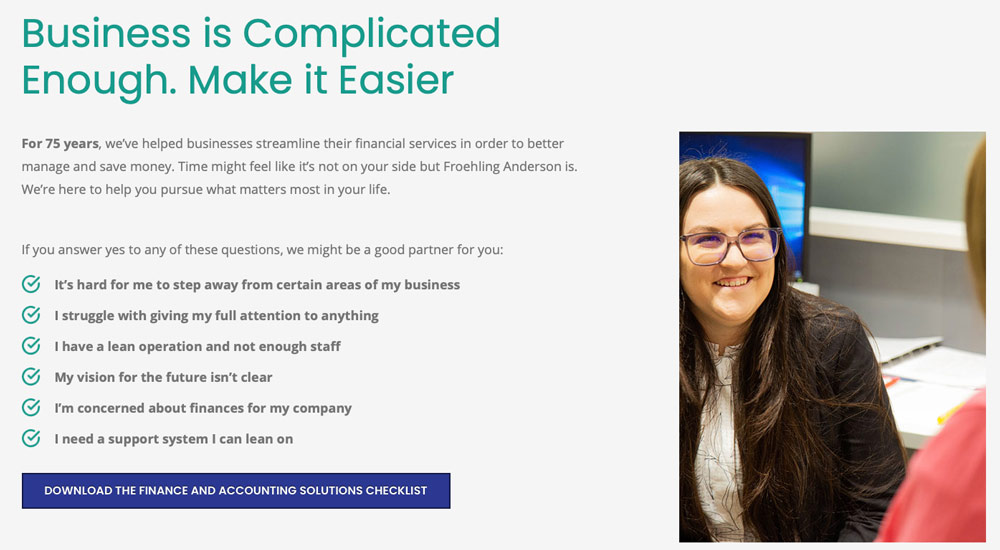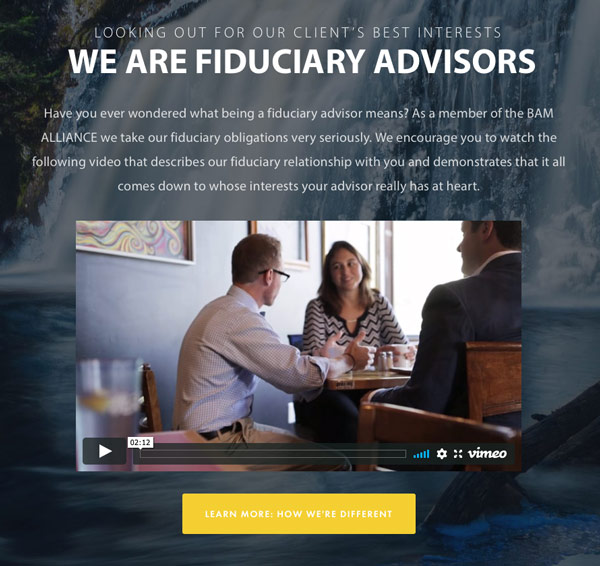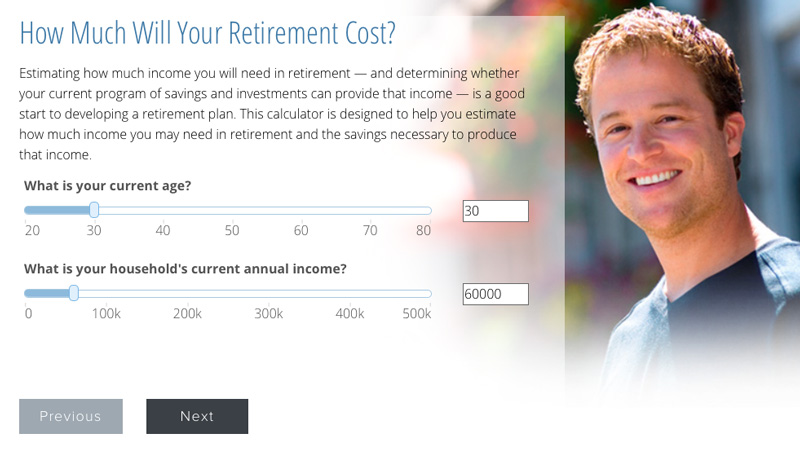
1) Maximize Minimalism
The easiest mistake to make when it comes to financial website design is getting too carried away. While it may seem instinctive to provide visitors to your website with as much informative copy, graphics, and videos as possible, you don’t want bombardment to be people’s first impression of your site.
In the example above from Meath Finance Advisors, they demonstrate in simple terms three distinct ways their firm benefits its customers. "Have Clarity", "Feel at Ease" and "Make an Impact"; powerful language, accompanied by simple iconographic design does the trick in this instance.
Sometimes appropriate spacing, short and precise paragraphs, and sleek visuals are all you need to entice visitors into sticking around and learning more about your financial services.
Here are a few inspiring examples of financial web designs that effectively embrace modern minimalistic web pages.
2) Accessible Navigation
A minimal and modern design accompanied by sleek, inviting graphics and visuals means absolutely nothing if online visitors can’t efficiently navigate their way through your financial website. People will leave your site with even the slightest frustrating experience.
To ensure you’re not testing your visitors’ patience, make sure any menu bars you have are prominently displayed at the top of your homepage, and all your online services can be seen and accessed without having to scroll around all over the place. The lesser amount of clicks one performs to absorb your website, the greater their patience and activity will be.
3) Engaging Visuals
Given that the majority of the population do not work in financial services, you should assume that processing monetary information can be considered as somewhat intimidating for most of your website traffic. Reading paragraphs of financial service information could be difficult for potential clients to retain, let alone feel compelled to read. This is where congenial, instructional, and polished visuals can do wonders for educating online visitors on what exactly it is you can provide for them.
In the financial industry, you deal with a lot of high-net-worth individuals, complex corporations and small businesses, among others. In other words, you serve people who don't have a lot of time.
That's why it's so crucial to communicate your unique value propositions (UVPs) immediately and succinctly. In the above example from Froehling Anderson, a CPA firm in Minneapolis, you can see that they make it easy as possible for the user to understand how they stand to benefit by choosing them.
Presenting information in a "question - answer" format is a creative way to both intrigue the reader and provide them with crucial UVPs. Rather than over-selling, they're providing a helpful, "lean-on-me" brand voice.
Also, avoid generic stock images and settle on imagery that’s in line with your branding and website aesthetic to help break up monotonous text. Even some simple graphics or pie charts illustrating various statistics or figures can do wonders for maintaining engagement.
4) Competent Mobility
Speaking of accessible navigation, if your mobile website performance isn’t on point, you could potentially be cutting your amount of possible online visitors and clients in half. More than fifty percent of Google searches are conducted on smartphones, and studies show that the younger generations predominately access the Internet via mobile phone. You need to devote just as much time and effort into your mobile site design as you are into your standard website, so make sure menus and navigation bars aren’t too small to tap on via phone, as well as ensuring loading and refresh times are as efficient as possible.
Find more helpful information, by reading our post: Best Web Design Inspiration
5) Inviting Videos
There’s no easier way to drive engagement and increase time spent on your financial website than including informative and interesting videos on your webpage. In fact, complementing your print or copy with relevant videos has been proven to boost website engagement and online user activity.
Many visitors to your website will feel more compelled to spend thirty seconds watching an animated short depicting all the ways your company can financially assist them than spending the same amount of time reading blocks of paragraphs. Intriguing videos are an opportunity for you to separate yourself from the rest of the pack with accessible content that enhances engagement and provides visitors with easily digestible information.
In this financial website example from Klane Wealth Management, a professionally produced and edited video takes the spotlight. The great thing about video is that it not only easily and clearly communicates your UVPs, it evokes emotion through the use of music, certain camera angles, lighting, etc.
For those fiduciary advisors that are having trouble humanizing your website, a video might be the ideal option to improve time on page metrics and conversion metrics.
6) Stay Social
If you haven’t learned by now, no matter what your company provides for clients, having a social media presence is an absolute necessity to help garner more traffic and engagement for your financial website. Make sure you're putting social media front and center on your website, similar to the Edina wealth management company website, Flourish:
You can see how they put their podcast and audio content front-and-center, with a row of social icons at the bottom of their home page header. Give the user options, but tell them what's most important to understanding your brand. Make that aspect shine through in your overall website layout.
Also keep in mind – the frequency and scheduling of your social media posts will have a direct impact on the number of people intentionally or organically accessing your website. Even if you’re occasionally retweeting resourceful financial tips or sharing one money-management article on Facebook every day, that little effort can make a world of difference in terms of driving traffic to your page. An easy way to reach new audiences and create shareable content is by starting a blog, featuring relevant and informational financial content that can then be posted on all your social media channels.
7) Strong Security
People are becoming more skeptical of the websites they visit and their online activity in general every day. And if you’re dealing with sensitive financial information for your clients, they’ll have more to worry about then blocking advertisements or clicking out of pop-ups. For a relatively small investment, you can secure an SSL Certification for your financial website, which will ensure your users are accessing an encrypted connection and help boost your line defense against hackers. This is the least you can do to help put your clients’ minds at ease when it comes to providing them with financial assistance.
Browse the best marketing tools to improve your financial company's outreach, read our post: 8 Powerful Tools to Improve Your Financial Marketing
8) Practical Gadgets
Another way to increase user engagement on your financial website is to provide online visitors with a number of engrossing gadgets, applications, or resources related to financial management. The goal here is to solve an issue for the consumer.
Budget or debt calculators are always enticing for visitors to click on, and can help them understand how much they actually need some financial assistance. Other examples of resourceful widgets or badges include thumbnail stock charts, exchange rate charts, or virtual balance trackers. All of these applications can be utilized to incentivize website visitors into becoming clients.
For example, the retirement calculator above solves the issue of people's financial planning throughout their life. Once the calculator runs its equations — providing its value — the final results are accompanied by a call-to-action centered around retirement planning services.
9) Strategic SEO
Effective financial website SEO is crucial in building brand awareness, driving traffic to your content and capturing leads to grow business. If you’re still unfamiliar with the advantages successful Search Engine Optimization can provide for you, it’s better late than never to enlighten yourself. SEO improves both the technical backend of your website for higher performance and the front-end content that gets ranked in search results. To put it simply, taking advantage of proficient SEO strategies is what can make or break your financial website performance when it comes to reaching your intended audience. Of course, it's easier said than done...
...for an in-depth dive on improving your financial website's SEO, read our guide: SEO 101: Best Practices to Build a Better Brand.
10) Call-To-Action
Providing your online visitors with Call-To-Action opportunities is a true means to measure and evaluate user engagement within your financial website. Anything that encourages and initiates interaction between a visitor and your web page can be considered call-to-action. Contact resources, assistance chats, newsletter sign-ups, social media buttons; all of these are examples of call-to-action options that can be hyperlinked or clicked on to establish and enhance visitor engagement for your financial website.
11) Bonus: Take Security Seriously
Whether you operate a online banking portal, investment dashboard, financial planning software or deal with user data in some other private way, a secure website is a basic aspect of doing business and crucial in maintaining consumer trust. And, if you’re one of the 400 million people who use WordPress, you should know the ins and outs of protecting your properties from cyberattacks. Login credentials, email addresses or personal information can all be sold on the black market or exploited for further cyber attacks.
So if this has you worried, let’s take quickly take a look at the most common WordPress security vulnerabilities and how to protect your financial company’s back end.
1. Brute Force Attacks
Brute force attacks are a vicious attempt by hackers to break into your account by trying several username and password combinations. Depending on the strength of your password, they may be able to guess or use an automated processing system that runs through countless password combinations.
The easiest way to keep your accounts secure from brute force attacks is to ensure you have a strong, unique password. Cybersecurity experts propose the use of three-phrase passwords, as they are easy to remember yet hard to crack. An example is “roses and bosses.” Also, don’t forget to add a combination of numbers and symbols, along with varying capitalizations. If you tend to “recycle” passwords, you put yourself at more risk, as they may have been exposed in past data breaches from other platforms.
2. SQL Injections
MySQL powers the WordPress database. SQL stands for Structured Query Language, and was built in order to manage large databases. Unfortunately, hackers can gain full access to any website if they can gain access to its database, and it’s an extremely effective way to get access to sensitive information. Once in the database, hackers can plant content (SQL injections) to spam websites, ads and other malicious content.

SQL injections have been the subject of numerous attacks, including cyber security firm Sophos’ website in 2020 — which just goes to show that no one is safe. Stolen data included username and passwords, emails and other personal information. For an easy way to protect your WordPress site from SQL attacks, try out the popular Sucuri Security Scanner plugin.
3. Malware
It’s impossible to discuss WordPress security vulnerabilities without mentioning malware. The simplest definition of malware is “malicious software.” These attacks come in different forms, including:
Viruses
- A virus is a self-replicating malware that is activated by the user but eventually takes over the hosting server.
Adware
- While this may be the least harmful, it can be extremely annoying. Adware comes with most free themes, software, and plugins.
Spyware
- As the name suggests, its work is to capture user-generated information and dump it where the hacker can access it.
Keylogger
- Hackers use a keylogger to collect passwords. It logs all the keystrokes during a specific action. Naturally, a username is always followed by a password.
Ransomware
- The latest and the most ferocious of all malware. It takes over the user’s files, database, or server until a ransom is paid. Very few of these can be successfully mitigated without paying a specialist.
4. Avoiding WordPress Vulnerabilities
While you may not be able to stave off all of the security vulnerabilities mentioned above, you can avoid most of them. Certain companies, like a financial institution, for example, have a responsibility to their customers to protect their most basic information, from simple things like name, email, phone number and address to more severe items like social security number and credit card numbers. Below are some WordPress development tips which will keep your site safe:
Obtain Themes From Trustworthy Sources
Plugins and themes are the primary ways through which most people get into trouble. If you’re doing it yourself, do not download any of these from untrusted sources — rather, use reliable dealers like WordPress.org and ThemeForest.net. Those with coding experience can build fully custom WordPress sites. This way, you have full control over what security measures are or are not implemented.
Update Your Plugins
Old and outdated plugin code creates a ton of vulnerabilities that are ripe for attack. Stay safe by keeping all your plugins and themes up to date. In addition, keep WordPress and your theme as up-to-date as possible. Set up automatic updates on your website, if possible. Install Sucuri and run consistent malware scans to keep spammers at bay.
Make Regular Website Backups
When you make regular backups of your site, you can always simply re-install content back to its original form after an attack. Create a reliable backup strategy that keeps the WordPress backup in a safe and secure location offline. There are a ton of plugins available, with the most popular being UpdraftPlus.
Stronger Web Development, Stronger Security
Cybercrime has reached an all-time peak with hackers resorting to more technical and daring methods. However, with the above web development tips in place, you can secure your financial website from both basic and advanced attacks.
Do you want to improve the look, functionality and effectiveness of your financial website?
Frahm Digital can help develop a strong web presence for you. From luxury web design to compelling copywriting to strategic SEO, we've enhanced countless brands around the U.S. – and can do the same for you.
If you're interested in learning what it's like to work with us, click the button below to receive a no-hassle, 100%-free website audit. We'll provide you with actionable insights for your financial-based website.







